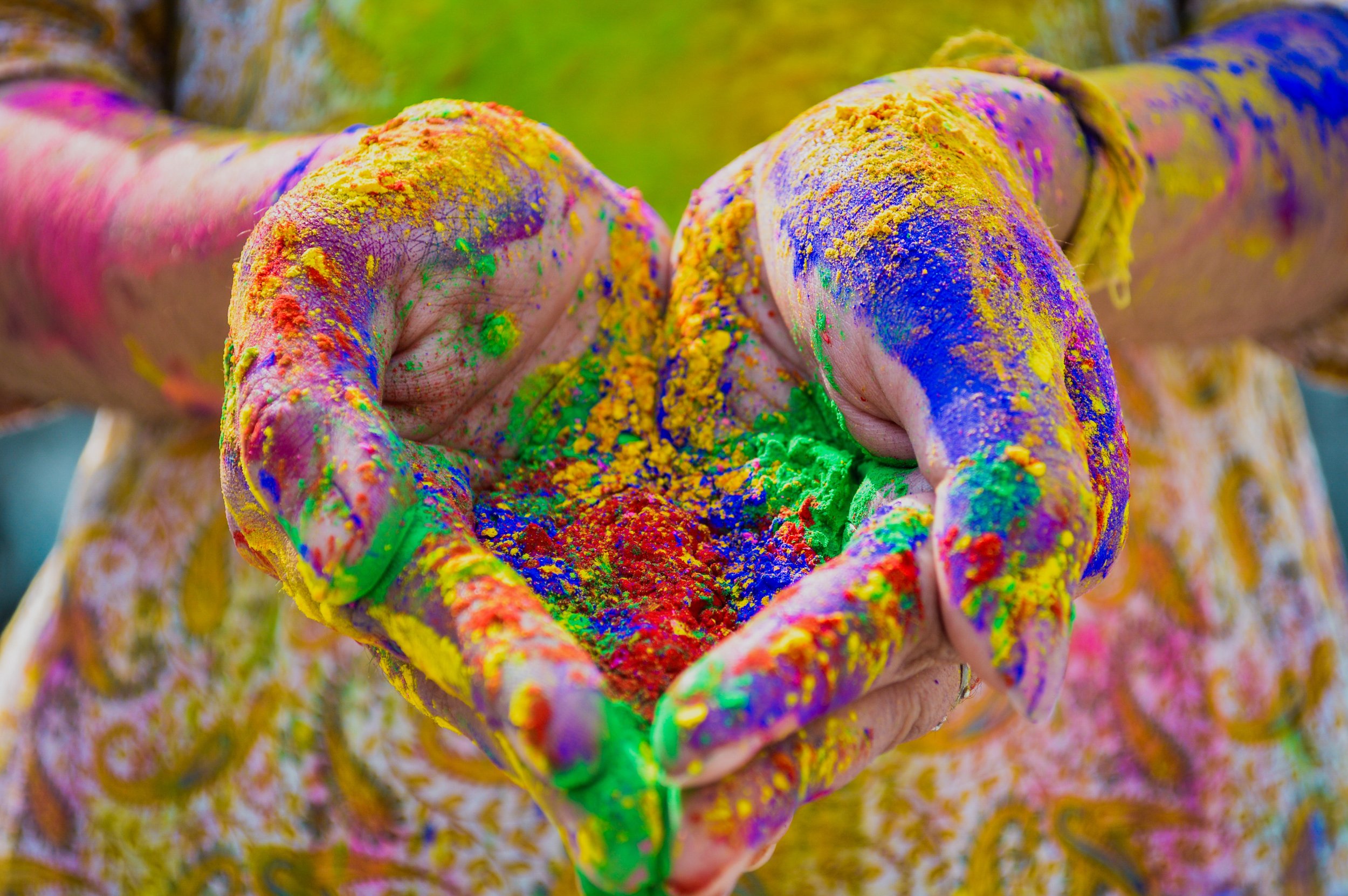How to Celebrate Holi
Holi, also known as the Festival of Colors, is a vibrant ancient Hindu festival mainly celebrated in India and Nepal. It marks the end of Winter and welcomes the Spring season, symbolic of good triumphing over evil. The festival begins on the night before Holi.
Bonfires are lit and people gather around while eating traditional foods. The second day of the festival is when people celebrate by gathering in groups and splashing brilliantly colored dyes at each other.
Every year, Holi is observed on the last full moon day of the Hindu lunisolar calendar month.
Holi is also known as the “Festival of Colours, Love and Spring”.
Learn more about Holi in our March Observances Calendar!
History of Holi
Holi has been celebrated for centuries, but the meaning of the festival has evolved overtime.
In the beginning, Holi was known to be a commemoration for married women to honor their new family and married life with peace and prosperity.
In modern days, one of the main themes of Holi is the celebration of victory of good over evil, symbolizing the end of winter and the beginning of warmer weather.
The origins of Holi stems from a mix of Hindu mythology including the popular legend of Hiranyakashipu, a demon King who believed he was immortal. His son, Prahlad, was a devotee to a Hindu deity named Vishnu, and it frustrated Hiranyakashipu that his own son would worship Vishnu over him. Based on the legend, Vishnu ended up killing Hiranyakashipu, and thus, good triumphed over evil
The other popular legend often associated with Holi is the story of Krishna and Radha. Krishna is a God with blue skin, and fell in love with a milkmaid named Radha, but was worried that Radha wouldn’t feel the same love due to the color of his skin. Radha let Krishna apply coloured paint to her skin and they then fell in love, which led to the start of the Festival of Colors.
Traditionally, the colors used in Holi were made from flowers and herbs that formed into bright, natural dyes due to the hot climate. Today, however, they are usually synthetic. There are four main colors and each carries a different meaning. Red is meant for love and fertility, yellow symbolizes turmeric which acts as a natural remedy, blue symbolizes Krishna, and green represents a new Spring season and a fresh start.
Holi is one of the most celebrated and inclusive festivals in South Asia and in many countries throughout the world. In Canada, where a large number of Indian populations reside, the celebration of the festival of Holi is very popular. The festival of Holi brings with itself harmony, peace, and a feeling of being at home for those living in Canada.
How Holi is Celebrated
First Day - Holika Dahan
On the Eve of the festival, typically after sunset, a ritual takes place. Large pyres are lit to symbolize the burning of evil spirits. Wood, dried leaves, debris, and twigs are often thrown into the bonfires. Families will dance and sing around the fire, and also pray for happiness, love, and prosperity.
Second Day - Rangwali Holi
The next day, directly after the full moon, is meant for celebration, fun, and entertainment. People visit their friends and family to wish them a happy Holi and also exchange sweets, gifts, and put vibrant colors on each other’s faces. Throughout the day, people go into the streets to throw coloured powder at each other, have water gun fights, sing, dance, and play pranks on each other.
The festival gives a chance to learn about the love between Lord Krishna and his beloved Radha. This day is meant for everyone to abandon all their worries and let them embrace new changes in their lives for a better way of living. The noise and colorful entertainment associated with Holi symbolizes the feeling of brotherhood and a sense of unity.
Interesting Facts about Holi
The name Holi comes from “Holika”, the evil sister of the demon King named Hiranyakashyap.
Water is a big part of Holi as many people use water balloons and water guns to engage in water fights with their family and friends.
Holi was the first festival in India that taught the theme of equality. People come together to celebrate this observance despite differences in caste, culture, and religion. This festival is an attempt to diminish boundaries between groups and promote peace and new beginnings.
In the region of India where Krishna, the Hindu god, was born, Holi lasts up to 16 days.
The festival of Holi is evolving, and has spread beyond India and Nepal to several areas around the world. Other countries, including the Philippines, Guyana, Trinidad and Tobago, Mauritius, Barcelona, Fiji, and the major cities in the UK, USA, and Canada, all take part in celebrating Holi.
How to Celebrate Holi in the Workplace
Allow for Paid Time Off
Accommodate requests off for Holi. An employer should present options to any employee who celebrates the holiday to take time off without losing wages or having to use their vacation time. Paid time off allows your employees to enjoy this festival with their loved ones without having to stress.
Don’t Make Assumptions
People feel different emotions during the holidays, and not everybody who celebrates Holi will do so in the same way. There may be some employees who will take time off or want to have open conversations about the holiday with their colleagues, while others may prefer to stay quiet or may not wish to participate in the festivities.
Potluck Lunch
Whether your workplace is big or small, organizing a potluck lunch in commemoration of Holi is a great way to celebrate this holiday with colleagues. This can be done by making a list of traditional foods that staff can bring in, and coordinating with employees to ensure there is diversity in the dishes.
The planning that goes into potlucks encourages employees to both collaborate and interact with each other, which will increase their engagement and job satisfaction.
Provide Resources
Honoring the Festival of Holi in the workplace is an important way to show appreciation, but festivities that ignore the history and philosophy behind Holi risk becoming appropriation. Send out an email or provide accessible resources in the office that include information about Holi so everyone can learn more about the significance of this holiday.
Well Wishes and Greetings
The theme of Holi marks spreading positivity and warmth amidst each other and this also holds true for work colleagues. An email, greeting card or a note is a perfect way to let your employees know that you recognize this holiday and value their culture.
Decorations
Using colorful decorations such as flowers to decorate the office will add a touch of tradition and culture throughout your workplace. Decorations for any holiday should always be respectful for all employees. Ensure that when choosing to decorate the workplace as a way to commemorate Holi, the decorations are appropriate and do not impact anyone’s ability to work or move around the office.
The Wall Of Colors
The spirit of Holi represents playfulness and inclusivity, so people of other faiths and backgrounds are often welcomed to join in on the fun. A fun festivity to consider partaking in the office is a color wall. Get a big canvas and allow employees to dip their hands in a color of paint and pat it on the board. The board will be full of different and bright hand impressions. Later, you can get a quote related to teamwork or unity written on the canvas and it can be put up on the wall to be displayed.
This is a great way to not only add some decor in the office, but it would also increase employee engagement while commemorating the holiday. Remember to mention to all employees that participation is optional!


